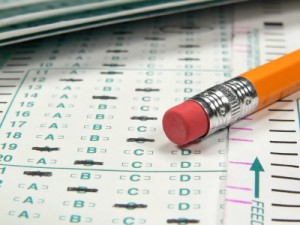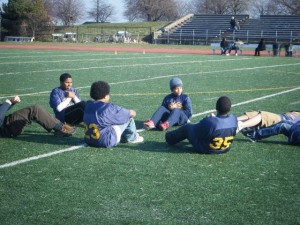Running Backs and NFL Stats: Pairing Math and Football in the Classroom
George Ganzenmuller is a Second Year Teaching Fellow at the Edwards Middle School, Charlestown, MA
One of the things we do very well at Citizen Schools is bring volunteers into the classroom to teach students apprenticeships on subjects that they’re passionate about. As a Teaching Fellow, I’m able to teach my own apprenticeships, and what I’m passionate about is getting kids active.
But here’s the problem. Since the standards-based education reform movement of the last 20 years, schools are now judged (almost entirely) based on how students score on standardized tests. As a nonprofit which partners with struggling schools, Citizen Schools is largely rated on our impact on student test scores.
Since taking this job in 2010, I’ve been wrestling with the implications of this reality. I know that the obstacles facing the students that we serve are monumental, and without building the proper skills and abilities they’ll have a tough time overcoming them. I know how important it is to give our students an extra hour of math per day.
I also know it’s important give my students some time to run around and, well, be children.
Last month, it came to a head. My colleagues at HQ asked me to make my flag football apprenticeship a STEM course—to demonstrate that I was building my students’ skills in either Science, Technology, Engineering, or Math.
Somehow education reform has come to this: even physical activity has to be justified with an academic angle. I was frustrated because state standards were encroaching on my students already too limited time to be active.
But, that’s the service we provide at Citizen Schools. I knew that in order to make those 90 minutes count, I needed to find a way to teach math competency and flag football at the same time.
Problem was, I had no idea how I was going to do it.
Then it came to me, as I was sitting down for my fantasy football draft . Have them draft their own fantasy teams, play against each other and calculate their own scores (I'm not the first to have this idea). They’d be using division, multiplication, addition, negative numbers, averages—and they’d enjoy doing it. Perfect.
Two crises, one stone.
So far, we’ve had 5 classes. Each student has a fantasy football team of five players (1QB, 2RBs, 2WRs).We start each class with 20 minutes of score tallying and statistics assessing, and then transition outside for 60 minutes of flag football drills. They’ve gotten so quick at calculating their scores that I’ve been able to mix in some more challenges like averaging scores and predicting next week’s outcomes. They’ve learned football rules, passing routes, defensive techniques, offensive strategies and even developed our own team chant.
I still harbor a healthy concern about how all of this standardized testing is going to impact our children and our country. But on this occasion, I am pleasantly surprised. Maybe we can make learning active mentally and physically.
What ideas do you have for pairing physical activity with academic rigor?


